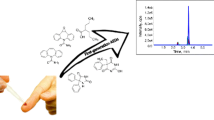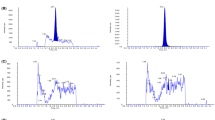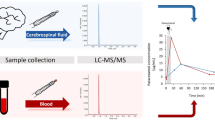Abstract
Mitotane is the only currently approved treatment for adrenocortical carcinoma (ACC), a rare endocrine malignancy. Plasma levels within the range of 14 to 20 mg L−1 are correlated with higher clinical efficacy and manageable toxicity. Because of this narrow therapeutic index and slow pharmacokinetics, therapeutic drug monitoring is an essential element of mitotane therapy. A small step towards the therapeutic drug monitoring (TDM) by volumetric absorptive microsampling (VAMS) was made with this work. A simple method enabling the patient to collect capillary blood at home for the control of mitotane blood concentration was developed and characterized using MITRA™ VAMS 20 μL microsampler. Dried blood samples were extracted prior to HPLC-UV analysis. Mitotane and the internal standard dicofol (DIC) were detected at 230 nm by ultra-violet detection after separation on a C8 reversed phase column. The assay was validated in the range of 1 to 50 mg L−1. Dried samples were stable at room temperature and at 2–8 °C for 1 week. At 37 °C, a substantial amount of the analyte was lost probably due to evaporation. Hematocrit bias, a common problem of conventional dried blood techniques, was acceptable in the tested range. However, a significant difference in recovery from spiked and authentic patient blood was detected. Comparison of mitotane concentration in dried blood samples (CDBS) by VAMS with venous plasma in patients on mitotane therapy demonstrated poor correlation of CDBS with the concentration in plasma (CP). In conclusion, application of VAMS in clinical routine for mitotane TDM appears to be of limited value in the absence of a method-specific target range.






Similar content being viewed by others
References
Fassnacht M, Terzolo M, Allolio B, Baudin E, Haak H, Berruti A, et al. Combination chemotherapy in advanced adrenocortical carcinoma. N Engl J Med. 2012;366(23):2189–97.
Cueto C, Brown JH. The chemical fractionation of an adrenocorticolytic drug. Endocrinology. 1958;62(3):326–33. https://doi.org/10.1210/endo-62-3-326.
Cueto C, Brown JH, Richardson AP Jr. Biological studies on an adrenocorticolytic agent and the isolation of the active components. Endocrinology. 1958;62(3):334–9. https://doi.org/10.1210/endo-62-3-334.
Terzolo M, Angeli A, Fassnacht M, Daffara F, Tauchmanova L, Conton PA, et al. Adjuvant mitotane treatment for adrenocortical carcinoma. N Engl J Med. 2007;356(23):2372–80. https://doi.org/10.1056/NEJMoa063360.
Berruti A, Fassnacht M, Baudin E, Hammer G, Haak H, Leboulleux S, et al. Adjuvant therapy in patients with adrenocortical carcinoma: a position of an international panel. J Clin Oncol. 2010;28(23):e401–2. https://doi.org/10.1200/JCO.2009.27.5958.
European Medicines Agency. Lysodren: summary of product characteristics. 2009, http://www.ema.europa.eu/docs/en_GB/document_library/EPAR_-_Product_Information/human/000521/WC500047235.pdf. Accessed Apr 2018.
Kasperlik-Zaluska AA, Cichocki A. Clinical role of determination of plasma mitotane and its metabolites levels in patients with adrenal cancer: results of a long-term follow-up. J Exp Ther Oncol. 2005;5(2):125–32.
Hermsen IG, Fassnacht M, Terzolo M, Houterman S, den Hartigh J, Leboulleux S, et al. Plasma concentrations of o,p′DDD, o,p′DDA, and o,p′DDE as predictors of tumor response to mitotane in adrenocortical carcinoma: results of a retrospective ENS@T multicenter study. J Clin Endocrinol Metab. 2011;96(6):1844–51. https://doi.org/10.1210/jc.2010-2676.
Hescot S, Paci A, Seck A, Slama A, Viengchareun S, Trabado S, et al. The lack of antitumor effects of o,p′DDA excludes its role as an active metabolite of mitotane for adrenocortical carcinoma treatment. Horm Cancer. 2014;5(5):312–23. https://doi.org/10.1007/s12672-014-0189-7.
Megerle F, Herrmann W, Schloetelburg W, Ronchi CL, Pulzer A, Quinkler M, et al. Mitotane monotherapy in patients with advanced adrenocortical carcinoma. J Clin Endocrinol Metab. 2018;103(4):1686–95. https://doi.org/10.1210/jc.2017-02591.
Baudin E, Pellegriti G, Bonnay M, Penfornis A, Laplanche A, Vassal G, et al. Impact of monitoring plasma 1,1-dichlorodiphenildichloroethane (o,p'DDD) levels on the treatment of patients with adrenocortical carcinoma. Cancer. 2001;92(6):1385–92.
van Slooten H, Moolenaar AJ, van Seters AP, Smeenk D. The treatment of adrenocortical carcinoma with o,p′-DDD: prognostic implications of serum level monitoring. Eur J Cancer Clin Oncol. 1984;20(1):47–53.
Feliu C, Cazaubon Y, Guillemin H, Vautier D, Oget O, Millart H, et al. Therapeutic drug monitoring of mitotane: analytical assay and patient follow-up. Biomed Chromatogr. 2017;31(11):e3993. https://doi.org/10.1002/bmc.3993.
Daffara F, De Francia S, Reimondo G, Zaggia B, Aroasio E, Porpiglia F, et al. Prospective evaluation of mitotane toxicity in adrenocortical cancer patients treated adjuvantly. Endocr Relat Cancer. 2008;15(4):1043–53. https://doi.org/10.1677/ERC-08-0103.
Terzolo M, Pia A, Berruti A, Osella G, Ali A, Carbone V, et al. Low-dose monitored mitotane treatment achieves the therapeutic range with manageable side effects in patients with adrenocortical cancer. J Clin Endocrinol Metab. 2000;85(6):2234–8. https://doi.org/10.1210/jcem.85.6.6619.
Faggiano A, Leboulleux S, Young J, Schlumberger M, Baudin E. Rapidly progressing high o,p′DDD doses shorten the time required to reach the therapeutic threshold with an acceptable tolerance: preliminary results. Clin Endocrinol. 2006;64(1):110–3. https://doi.org/10.1111/j.1365-2265.2005.02403.x.
Mauclere-Denost S, Leboulleux S, Borget I, Paci A, Young J, Al Ghuzlan A, et al. High-dose mitotane strategy in adrenocortical carcinoma: prospective analysis of plasma mitotane measurement during the first 3 months of follow-up. Eur J Endocrinol. 2012;166(2):261–8. https://doi.org/10.1530/EJE-11-0557.
Arshad U, Taubert M, Kurlbaum M, Frechen S, Herterich S, Megerle F, et al. Enzyme autoinduction by mitotane supported by population pharmacokinetic modelling in a large cohort of adrenocortical carcinoma patients. Eur J Endocrinol. 2018;179(5):287–97.
Kerkhofs TM, Derijks LJ, Ettaieb H, Den Hartigh J, Neef K, Gelderblom H, et al. Development of a pharmacokinetic model of mitotane: toward personalized dosing in adrenocortical carcinoma. Ther Drug Monit. 2015;37(1):58–65.
Kerkhofs T, Baudin E, Terzolo M, Allolio B, Chadarevian R, Mueller H, et al. Comparison of two mitotane starting dose regimens in patients with advanced adrenocortical carcinoma. J Clin Endocrinol Metab. 2013;98(12):4759–67.
Fassnacht M, Kroiss M, Allolio B. Update in adrenocortical carcinoma. J Clin Endocrinol Metab. 2013;98(12):4551–64.
Andersen A, Kasperlik-Zaluska AA, Warren DJ. Determination of mitotane (o,p-DDD) and its metabolites o,p-DDA and o,p-DDE in plasma by high-performance liquid chromatography. Ther Drug Monit. 1999;21(3):355–9.
Garg MB, Sakoff JA, Ackland SP. A simple HPLC method for plasma level monitoring of mitotane and its two main metabolites in adrenocortical cancer patients. J Chromatogr B Anal Technol Biomed Life Sci. 2011;879(23):2201–5. https://doi.org/10.1016/j.jchromb.2011.06.001.
De Francia S, Pirro E, Zappia F, De Martino F, Sprio AE, Daffara F, et al. A new simple HPLC method for measuring mitotane and its two principal metabolites tests in animals and mitotane-treated patients. J Chromatogr B Anal Technol Biomed Life Sci. 2006;837(1–2):69–75. https://doi.org/10.1016/j.jchromb.2006.04.005.
Mornar A, Sertic M, Turk N, Nigovic B, Korsic M. Simultaneous analysis of mitotane and its main metabolites in human blood and urine samples by SPE-HPLC technique. Biomed Chromatogr. 2012;26(11):1308–14. https://doi.org/10.1002/bmc.2696.
Guthrie R, Susi A. A simple phenylalanine method for detecting phenylketonuria in large populations of newborn infants. Pediatrics. 1963;32:338–43.
Enderle Y, Foerster K, Burhenne J. Clinical feasibility of dried blood spots: analytics, validation, and applications. J Pharm Biomed Anal. 2016;130:231–43. https://doi.org/10.1016/j.jpba.2016.06.026.
De Kesel PM, Lambert WE, Stove CP. Does volumetric absorptive microsampling eliminate the hematocrit bias for caffeine and paraxanthine in dried blood samples? A comparative study. Anal Chim Acta. 2015;881:65–73. https://doi.org/10.1016/j.aca.2015.04.056.
Denniff P, Spooner N. Volumetric absorptive microsampling: a dried sample collection technique for quantitative bioanalysis. Anal Chem. 2014;86(16):8489–95. https://doi.org/10.1021/ac5022562.
Kok MGM, Fillet M. Volumetric absorptive microsampling: current advances and applications. J Pharm Biomed Anal. 2018;147:288–96. https://doi.org/10.1016/j.jpba.2017.07.029.
European Medicines Agency. Guideline on Bioanalytical Method Validation. 2015, https://www.ema.europa.eu/documents/scientific-guideline/guideline-bioanalytical-method-validation_en.pdf. Accessed Mar 2018.
Inouye M, Mio T, Sumino K. Use of GC/MS/SIM for rapid determination of plasma levels of o,p′-DDD, o,p′-DDE and o,p′-DDA. Clin Chim Acta. 1987;170(2–3):305–14.
Evans C, Arnold M, Bryan P, Duggan J, James CA, Li W, et al. Implementing dried blood spot sampling for clinical pharmacokinetic determinations: considerations from the IQ Consortium Microsampling Working Group. AAPS J. 2015;17(2):292–300. https://doi.org/10.1208/s12248-014-9695-3.
Bland JM, Altman DG. Statistical methods for assessing agreement between two methods of clinical measurement. Lancet. 1986;1(8476):307–10.
R Core Team. R: a language and environment for statistical computing. Vienna: R Foundation for Statistical Computing; 2017.
McBride GB. A proposal for strength of agreement criteria for Lin’s Concordance Correlation Coefficient. NIWA Client Report; 2005.
Shawa H, Deniz F, Bazerbashi H, Hernandez M, Vassilopoulou-Sellin R, Jimenez C, et al. Mitotane-induced hyperlipidemia: a retrospective cohort study. Int J Endocrinol. 2013;2013:624962. https://doi.org/10.1155/2013/624962.
Benecke R, Vetter B, De Zeeuw RA. Rapid micromethod for the analysis of mitotane and its metabolite in plasma by gas chromatography with electron-capture detection. J Chromatogr. 1987;417(2):287–94.
U.S. Department of Health and Human Services Agency for Toxic Substances and Disease Registry. Toxicological profile for DDT, DDE, and DDD. 2002, https://www.atsdr.cdc.gov/toxprofiles/tp35.pdf. Accessed Mar 2018.
Xie I, Anderson M, Wang M, Xue L, Breidinger S, Goykhman D, et al. Extractability-mediated stability bias and hematocrit impact: high extraction recovery is critical to feasibility of volumetric adsorptive microsampling (VAMS) in regulated bioanalysis. J Pharm Biomed Anal. 2018;156:58–66.
Velghe S, Delahaye L, Stove CP. Is the hematocrit still an issue in quantitative dried blood spot analysis? J Pharm Biomed Anal. 2019;163:188–96.
Velghe S, Stove CP. Volumetric absorptive microsampling as an alternative tool for therapeutic drug monitoring of first-generation anti-epileptic drugs. Anal Bioanal Chem. 2018;410(9):2331–41.
Funding
This study was funded by Horphag Research (Europe) Ltd. and in part by the German Research Council (DFG, German Research Foundation) Projektnummer: 314061271 – TRR 205 as well as by an individual grant to M.F. (FA466/4-2) and M.K. (KR4371/1-2).
Author information
Authors and Affiliations
Corresponding author
Ethics declarations
Conflict of interest
The authors declare that they have no conflict of interest.
Research involving human participants
This study was part of the European Network for the Study of Adrenal Tumors (ENSAT) registry, which has been approved by the ethics committee of the University of Würzburg (approval number 86/03 and 88/11).
Informed consent
All patients provided written informed consent.
Additional information
Publisher’s note
Springer Nature remains neutral with regard to jurisdictional claims in published maps and institutional affiliations.
Electronic supplementary material
ESM 1
(PDF 2.43 MB)
Rights and permissions
About this article
Cite this article
Friedl, B., Kurlbaum, M., Kroiss, M. et al. A method for the minimally invasive drug monitoring of mitotane by means of volumetric absorptive microsampling for a home-based therapeutic drug monitoring. Anal Bioanal Chem 411, 3951–3962 (2019). https://doi.org/10.1007/s00216-019-01868-1
Received:
Revised:
Accepted:
Published:
Issue Date:
DOI: https://doi.org/10.1007/s00216-019-01868-1




